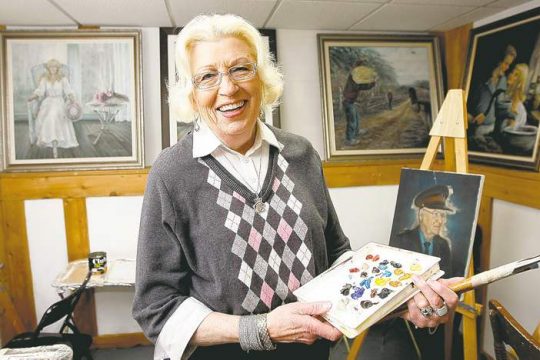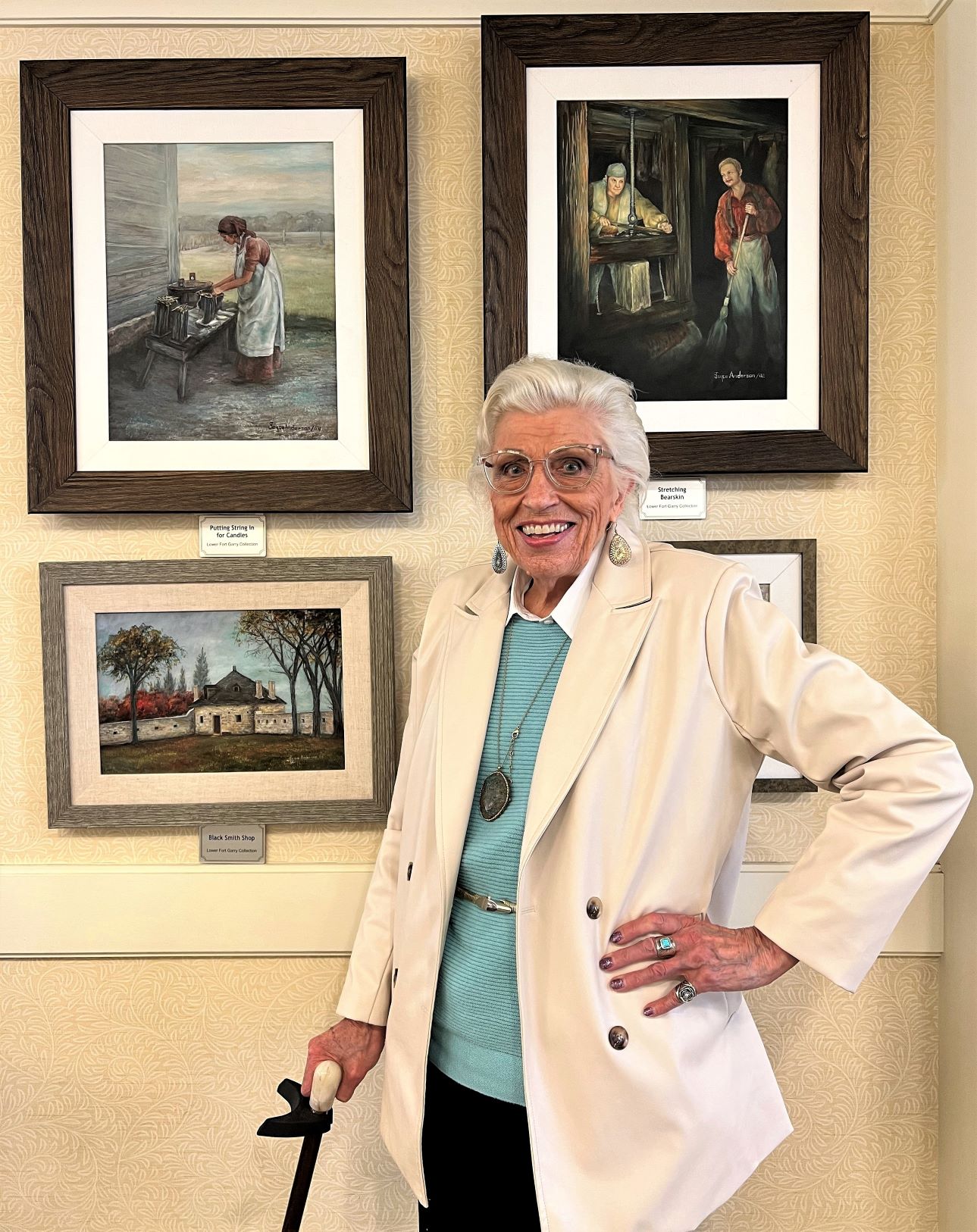
“Art is an expression of my life. Sometimes words can’t come close to describing how we feel, think, or how we see things in the world. But through my paintings and sculptures, I CAN express my thoughts and feelings.” – Joyce Anderson, artist statement
Joyce Anderson uses art to tune in to the joys of life, channeling everything else onto canvas.
Her childhood was not very kind. Passed from parent to parent and home to home, the shy girl learned to keep her feelings of loss and loneliness to herself. Her silence ended – and the feelings given an outlet – when Joyce, now 89, started to draw.
“Ladies shoes were my first subject,” Joyce laughs.
While living in a Winnipeg boarding house with her mother, at 5 Joyce was a withdrawn child. Perched at the top of a staircase, she would watch her housemates from a distance: two girls who were always singing or drawing. One day, Joyce built up the courage to asked for a pencil and paper so that she could try her hand at drawing. That instant sparked a life-long passion for art.
“It’s painful to think about it all because it brings back memories,” she said in a recent interview. “My mother left me, so I was sent to a children’s home. I had to learn a lot on my own.”
In one vignette, Joyce describes the trauma of moving to the Knowles School for Boys, where her father worked as a market gardener. She was 6 when she arrived, ill with starvation and impetigo.
Her father dealt with his own disappointments by throwing himself into work and, later, a new family. So young Joyce did not tell him about the schoolmates who taunted her or the teacher who encouraged them.

“Still,” she says, “my father must have seen something in me. I was about 13 years old when I started painting with oils. He built me an easel, bought me a little set of paints and a canvas.”
In 1952, while staying with a friend for a few years, Joyce started to paint in earnest. “I was resilient and resourceful because I knew there was another side of the fence,” she confides. Inspired by her history and a need to find her voice, she set her sights on building a better life for herself.
“It’s a craving, almost, inside of me that I need to get out,” she says, “I look at faces. I can tell what they’re feeling sometimes, and this inspires me to paint.”
How an Artist Becomes a Teacher

Mrs. Anderson, who has two children, four grandchildren, and four great grandchildren considers her paintings a gift to future generations — and to past ones.
Having met her husband of 44 years on a blind date, Joyce found herself worrying about the past, and about her young husband, a police officer. A quiet man, he supported her art, “Sometimes we all sat together, watching TV, while I painted,” Joyce reminisces, “I never thought that I would meet a person who cared about me. He was a wonderful man.”
As a young mother, Joyce was asked to teach art at her daughter’s school. Perhaps it was her humble attitude and gentle demeanor that drew people to her – the parents started asking for classes. In 1973 Joyce became an art instructor at Tec Voc high school continuing education program and held that position until closing of classes in 1994. During summers from 1991 through to 1997 she was art instructor at the International Music Camp Summer School of Fine Arts.
Joyce’s true talent is in her ability to develop & mentor the new and bashful artist. “I just demonstrate when I teach. There is such good fellowship [during classes] that it works inside of you,” she explains. “I try to inspire them. I suggest colours, brushes, and show them how to make the strokes. Then they feel the same way – they just want to paint!”
Joyce’s art has been featured in many galleries around Winnipeg, including the Winnipeg Art Gallery. In 1983 Joyce wanted to try some clay sculpturing. She won a few awards in this medium, including a Merit Award of a Clydesdale horse and her foal. When she has time, she enjoys creating fishermen in boats and figures of the Lower Fort Garry at work. To see samples of her paintings, click on the link to her web-site.

The Journey Continues at River Ridge Retirement Residence
Up until the start of the pandemic, students would come to her River Ridge retirement residence to learn the art form. Though most of her students come from outside the retirement home, where she has lived since 2013, many are fellow River Ridge residents. “A lot of them didn’t paint, didn’t do anything until they were 95 years old,” she said in a 2019 interview with CBC. “I was surprised that they would do that, and they were surprised at themselves. It’s a very good outlet for them.”
Of River Ridge, Joyce says that it was the best move that she ever made. After her husband passed away in 2005, her son and daughter were worried that she might fall on the stairs, so they searched for the best assisted living in Winnipeg. “It was just time,” she says. “It’s a wonderful place to live. I was still shy, but the staff reassured me and helped me to open up to other people! I joke around and talk to people now and feel freer than ever before.”
For Joyce, life has been a journey that has inspired her. “I have a love of painting and a love of people. I’m so fortunate to have such good friends.”
Retirement residences are home to unique and interesting individuals, each with their own extraordinary stories. As seniors transition to retirement living, All Seniors Care helps residents embark upon new chapters in their ever-changing stories. Through our “Sharing Stories” campaign, All Seniors Care senior homes celebrates residents by focusing on their life stories. To learn more about our assisted living in Winnipeg, retirement homes in Ottawa, or memory care in Hamilton, contact us today.
Feature Photo credit: Winnipeg Free Press Wednesday, Mar. 14, 2012
Writer – Julianna McLeod
Julianna is a health and wellness expert at All Seniors Care. Her mission is to create content that empowers older adults to form sustainable solutions for lasting health and happiness. She is an experienced writer, editor, and Recreational Therapist living in Toronto.